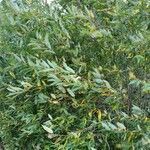Shrubs or trees, 4-6 m. Stems: branches flexible to highly brittle at base, yellow-brown, gray-brown, or red-brown, slightly to highly glossy, glabrous or villous to glabrescent; branchlets yellow-brown, gray-brown, or red-brown, glabrous, pilose, densely villous, or velvety, hairs spreading, straight, wavy, or crinkled. Leaves: stipules foliaceous, apex convex to rounded; petiole shallowly to deeply grooved adaxially, 5-13 mm, with clusters of spherical or foliaceous glands distally, glabrous, pilose, or densely villous adaxially; largest medial blade usually hypostomatous or hemiamphistomatous, rarely amphistomatous, lorate, very narrowly elliptic, narrowly elliptic, or lanceolate, (24-)55-133 × 11-43 mm, 2.5-6.2 times as long as wide, base convex or cuneate, margins flat, serrulate, apex acuminate to caudate, abaxial surface usually not glaucous (rarely so), glabrous, pilose, or moderately densely villous or long-silky, hairs appressed or spreading, white and/or ferruginous, straight or wavy, (coarse, caducous), adaxial (secondary veins flat or protruding), slightly or highly glossy, glabrous, pilose, or long-silky, hairs white and/or ferruginous; proximal blade margins entire and glandular-dotted, or serrulate or crenulate; juvenile blade reddish or yellowish green, glabrous or densely villous or long-silky abaxially, hairs white and ferruginous. Catkins: staminate 19-69 × 4-14 mm, flowering branchlet 5-23 mm; pistillate (fruiting in summer), moderately densely to loosely flowered, slender to stout, 23-56(-70 in fruit) × 8-12 mm, flowering branchlet 8-25 mm; floral bract 1.5-3 mm, apex convex or rounded, entire or toothed, abaxially sparsely hairy throughout or proximally, hairs wavy. Staminate flowers: abaxial nectary 0.5-1.1 mm, adaxial nectary square or ovate, 0.3-0.9 mm, nectaries connate and cup-shaped; stamens 3-6; filaments distinct, hairy on proximal 1/2 or basally; anthers ellipsoid, shortly cylindrical, obovoid, or globose, 0.6-0.8 mm. Pistillate flowers: adaxial nectary square or ovate, (swollen), 0.2-0.5 mm, shorter than stipe; stipe 0.5-2 mm; ovary pyriform, beak slightly bulged below or gradually tapering to styles; ovules 18-24 per ovary; styles connate or distinct 1/2 their lengths, 0.5-0.8 mm; stigmas flat, abaxially non-papillate with rounded tip, broadly cylindrical, or 2 plump lobes, 0.24-0.31-0.42 mm. Capsules 5-7 mm. 2n = 76.
More
Shrub or small tree to 6 m; bark brown, smooth; twigs and young lvs usually with caducous, reddish-brown hairs, otherwise glabrous, the twigs and buds shining, chestnut-brown; buds blunt, the scale with fused margins (as in spp. 5–30); stipules well developed and persistent, 2–5 mm, reniform to semilunate, glandular along the margin; lvs lanceolate to lance-ovate, 5–15 × 1.5–4 cm, 3–5 times as long as wide, mostly abruptly long-acuminate or attenuate, sharply glandular-serrate, shining green above, paler green beneath; petioles 5–15 mm, glandular at the tip; catkins with the lvs, 2–5 cm, on lateral leafy peduncles 1–2.5 cm, the scales yellow, thinly hairy, deciduous; stamens 3–6; fr lanceolate, 4.5–7 mm, glabrous; pedicels 0.5–1 mm; style 0.5–0.8 mm; 2n=76. Moist or wet low ground; Nf. and Lab. to Sask., s. to Del., W.Va., Io., and Nebr.; Roanoke Co., Va. Plants with the twigs and lower lf-surfaces ± persistently hairy are occasionally found in the n. part of our range (var. intonsa Fernald). A hybrid with no. 7 [Salix alba L.is S. ×jesupii Fernald.


